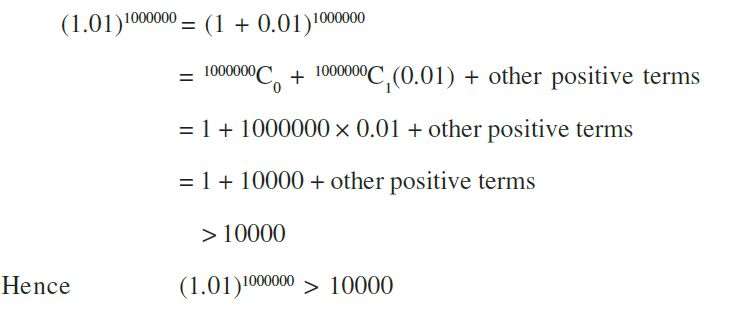1. Binomial Theorem for Positive Integral Indices
- Books Name
- AMARENDRA PATTANAYAK Mathmatics Book
- Publication
- KRISHNA PUBLICATIONS
- Course
- CBSE Class 11
- Subject
- Mathmatics
Chapter 8
Binomial Theorem
Binomial Theorem for Positive Integral Indices:
The Binomial Theorem is the method of expanding an Binomial expression that has been raised to any finite power.
Binomial Expression: A binomial expression is an algebraic expression that contains two dissimilar terms. Ex: a + b, a3 + b3,a-b, etc.
The binomial theorem states a formula for the expression of the powers of sums.

From the above representation, we can expand (a + b)n as given below:
(a + b)n = nC0 an + nC1 an-1 b + nC2 an-2 b2 + … + nCn-1 a bn-1 + nCn bn
This is the binomial theorem formula for any positive integer n.
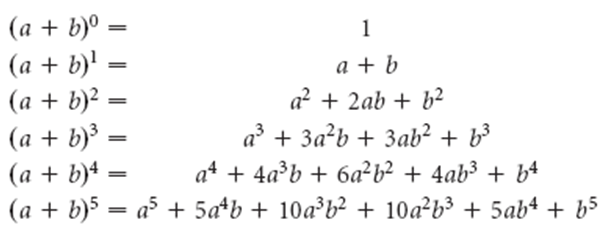
Some special cases from the binomial theorem can be written as:
- (x + y)n = nC0 xn + nC1 xn-1 by+ nC2 xn-2 y2 + … + nCn-1 x yn-1 + nCn xn
- (x – y)n = nC0 xn – nC1 xn-1 by + nC2 xn-2 y2 + … + (-1)n nCn xn
- (1 – x)n = nC0 – nC1 x + nC2 x2 – …. (-1)n nCn xn
Also, nC0 = nCn = 1
However, there will be (n + 1) terms in the expansion of (a + b)n.
Example: (√2 + 1)5 + (√2 − 1)5
Sol:
We have
(x + y)5 + (x – y)5 = 2[5C0 x5 + 5C2 x3 y2 + 5C4 xy4]
= 2(x5 + 10 x3 y2 + 5xy4)
Now (√2 + 1)5 + (√2 − 1)5 = 2[(√2)5 + 10(√2)3(1)2 + 5(√2)(1)4]
=58√2
Properties:
- The total number of terms in the expansion of (x+y)n are (n+1)
- The sum of exponents of x and y is always n.
- nC0, nC1, nC2, … .., nCn are called binomial coefficients and also represented by C0, C1, C2, ….., Cn
- The binomial coefficients which are equidistant from the beginning and from the ending are equal i.e. nC0 = nCn, nC1 = nCn-1 , nC2 = nCn-2 ,….. etc.
Some other expansions:
- (x + y)n + (x−y)n = 2[C0 xn + C2 xn-1 y2 + C4 xn-4 y4 + …]
- (x + y)n – (x−y)n = 2[C1 xn-1 y + C3 xn-3 y3 + C5 xn-5 y5 + …]
- (1 + x)n = nΣr-0 nCr . xr = [C0 + C1 x + C2 x2 + … Cn xn]
- (1+x)n + (1 − x)n = 2[C0 + C2 x2+C4 x4 + …]
- (1+x)n − (1−x)n = 2[C1 x + C3 x3 + C5 x5 + …]
- The number of terms in the expansion of (x + a)n + (x−a)n are (n+2)/2 if “n” is even or (n+1)/2 if “n” is odd.
- The number of terms in the expansion of (x + a)n − (x−a)n are (n/2) if “n” is even or (n+1)/2 if “n” is odd.
Question: Find the 4th term in the expansion of (x – 2y)12.
Solution:
The general term Tr+1 in the binomial expansion is given by Tr+1 = n C r an-r br
Here a= x, n =12, r= 3 and b = -2y
By substituting the values we get
T4 = 12C3 x9 (-2y)3

= -1760 x9 y3
2. Pascal’s triangle
- Books Name
- AMARENDRA PATTANAYAK Mathmatics Book
- Publication
- KRISHNA PUBLICATIONS
- Course
- CBSE Class 11
- Subject
- Mathmatics
Pascal’s triangle
An expression consisting of two terms, connected by + or – sign is called binomial expression. Binomial Theorem. If a and b are real numbers and n is a positive integer, then. The general term of (r + 1)th term in the expression is given by. Tr+1 = nCr an-r br.
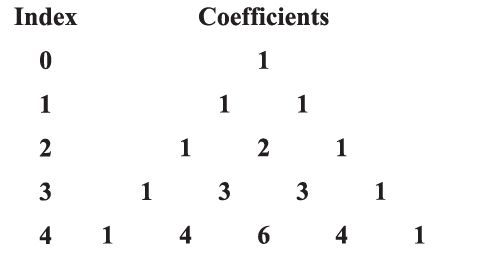
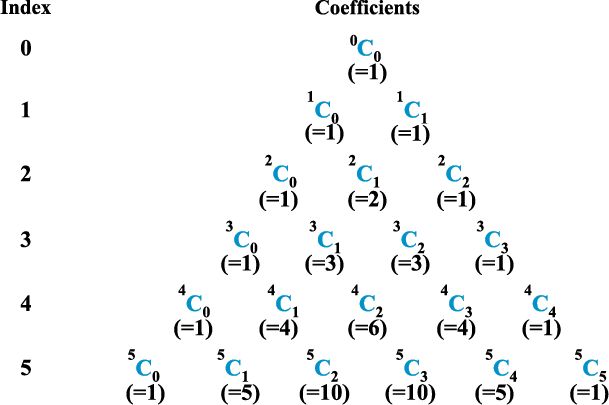
Example: (a + b)7 = 7C0 a7+ 7C1a6b + 7C2a5b2 + 7C3a4b3 + 7C4a3b4 + 7C5a2b5 + 7C6ab6 + 7C7b7
3. General and Middle Terms
- Books Name
- AMARENDRA PATTANAYAK Mathmatics Book
- Publication
- KRISHNA PUBLICATIONS
- Course
- CBSE Class 11
- Subject
- Mathmatics
General and Middle Terms
General Term in binomial expansion:
We have (x + y)n = nC0 xn + nC1 xn-1 . y + nC2 xn-2 . y2 + … + nCn yn
General Term = Tr+1 = nCr xn-r . yr
- General Term in (1 + x)n is nCr xr
- In the binomial expansion of (x + y)n , the rth term from end is (n – r + 2)th .
Example: Find the number of terms in (1 + 2x +x2)50
Sol:
(1 + 2x + x2)50 = [(1 + x)2]50 = (1 + x)100
The number of terms = (100 + 1) = 101
Example: Find the fourth term from the end in the expansion of (2x – 1/x2)10
Sol:
Required term =T10 – 4 + 2 = T8 = 10C7 (2x)3 (−1/x2)7 = −960x-11
Middle Term(S) in the expansion of (x+y) n
- If n is even then (n/2 + 1) Term is the middle Term.
- If n is odd then [(n+1)/2]th and [(n+3)/2)th terms are the middle terms.
![]()
Example: Find the middle term of (1 −3x + 3x2 – x3)2n
Sol:
(1 − 3x + 3x2 – x3)2n = [(1 − x)3]2n = (1 − x)6n
Middle Term = [(6n/2) + 1] term = 6nC3n (−x)3n
Determining a Particular Term:
- In the expansion of(axp + b/xq)n the coefficient of xm is the coefficient of Tr+1 where r = [(np−m)/(p+q)]
- In the expansion of (x + a)n, Tr+1/Tr = (n – r + 1)/r . a/x
Independent Term
The term Independent of in the expansion of [axp + (b/xq)]n is
Tr+1 = nCr an-r br, where r = (np/p+q) (integer)
Example: Find the independent term of x in (x+1/x)6
Sol:
r = [6(1)/1+1] = 3
The independent term is 6C3 = 20
Example :In the expansion of (1 + a)m+n, prove that coefficients of am and an are equal.
Solution:
We know that the general term Tr+1 in the binomial expansion is given by Tr+1 = nCr an-r br
Here n= m+n, a = 1 and b= a
Substituting the values in the general form
Tr+1 = m+n Cr 1m+n-r ar
= m+n Cr ar…………. (i)
Now we have that the general term for the expression is,
Tr+1 = m+n Cr ar
Now, For coefficient of am
Tm+1 = m+n Cm am
Hence, for coefficient of am, value of r = m
So, the coefficient is m+n C m
Similarly, Coefficient of an is m+n C n
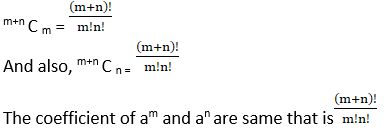
Example: Write the general term in the expansion of (x2 – y x)12, x ≠ 0.
Solution:
The general term Tr+1 in the binomial expansion is given by Tr+1 = n C r an-r br
Here n = 12, a= x2 and b = -y x
Substituting the values we get
Tn+1 =12Cr × x2(12-r) (-1)r yr xr

= -1r 12cr .x24 –2r. yr
Example: Which is larger (1.01)1000000 or 10,000?
Ans.:
Numerically greatest term in the expansion of (1+x)n:
- If [(n+1)|x|]/[|x|+1] = P, is a positive integer then Pth term and (P+1)th terms are numerically the greatest terms in the expansion of (1+x)n
- If[(n+1)|x|]/[|x|+1] = P + F, where P is a positive integer and 0 < F < 1 then (P+1)th term is numerically the greatest term in the expansion of (1+x)n.
Example: Find the numerically greatest term in (1-3x)10 when x = (1/2)
Sol:
[(n + 1)|α|] / [|α| + 1] = (11 × 3/2)/(3/2+1) = 33/5 = 6.6
Therefore, T7 is the numerically greatest term.
T6 + 1 = 10C6 . (−3x)6 = 10C6 . (3/2)6
Ratio of Consecutive Terms/Coefficients:
Coefficients of xr and xr + 1 are nCr – 1 and nCr respectively.
(nCr / nCr – 1) = (n – r + 1) / r
Example: If the coefficients of three consecutive terms in the expansion of (1+x)n are in the ratio 1:7:42 then find the value of n.
Sol:
Let (r – 1)th, (r)th and (r + 1)th be the three consecutive terms.
Then, the given ratio is 1:7:42
Now (nCr-2 / nCr – 1) = (1/7)
(nCr-2 / nCr – 1) = (1/7) ⇒ [(r – 1)/(n − r+2)] = (1/7) ⇒ n−8r+9=0 → (1)
And,
(nCr-1 / nCr) = (7/42) ⇒ [(r)/(n – r +1)] =(1/6) ⇒ n−7r +1=0 → (2)
From (1) & (2), n = 55
Applications of Binomial Theorem
Binomial theorem has a wide range of applications in Mathematics like finding the remainder, finding digits of a number, etc. The most common binomial theorem applications are:
Finding Remainder using Binomial Theorem
Example: Find the remainder when 7103 is divided by 25
Sol:
(7103 / 25) = [7(49)51 / 25)] = [7(50 − 1)51 / 25]
= [7(25K − 1) / 25] = [(175K – 25 + 25−7) / 25]
= [(25(7K − 1) + 18) / 25]
∴ The remainder = 18.
Example: If the fractional part of the number (2403 / 15) is (K/15), then find K.
Sol:
(2403 / 15) = [23 (24)100 / 15]
= 8/15 (15 + 1)100 = 8/ 15 (15λ + 1) = 8λ + 8/15
∵ 8λ is an integer, fractional part = 8/15
So, K = 8.
Finding Digits of a Number
Example: Find the last two digits of the number (13)10
Sol:
(13)10 = (169)5 = (170 − 1)5
= 5C0 (170)5 − 5C1 (170)4 + 5C2 (170)3 − 5C3 (170)2 + 5C4 (170) − 5C5
= 5C0 (170)5 − 5C1 (170)4 + 5C2 (170)3 − 5C3 (170)2 + 5(170) − 1
A multiple of 100 + 5(170) – 1 = 100K + 849
∴ The last two digits are 49.
Relation Between two Numbers
Example: Find the larger of 9950 + 10050 and 10150
Sol:
10150 = (100 + 1)50 = 10050 + 50 . 10049 + 25 . 49 . 10048 + …
⇒ 9950 = (100 − 1)50 = 10050 – 50 . 10049 + 25 . 49 . 10048 − ….
⇒ 10150 – 9950 = 2[50 . 10049 + 25(49) (16) 10047 + …]
= 10050 + 50 . 49 . 16 . 10047 + … >10050
∴ 10150 – 9950 > 10050
⇒ 10150 > 10050 + 9950
Divisibility Test
Example: Show that 119 + 911 is divisible by 10.
Sol:
119 + 911 = (10 + 1)9 + (10 − 1)11
= (9C0 . 109 + 9C1 . 108 + … 9C9) + (11C0 . 1011 − 11C1 . 1010 + … −11C11)
= 9C0 . 109 + 9C1 . 108 + … + 9C8 . 10 + 1 + 1011 − 11C1 . 1010 + … + 11C10 . 10−1
= 10[9C0 . 108 + 9C1 . 107 + … + 9C8 + 11C0 . 1010 − 11C1 . 109 + … + 11C10]
= 10K, which is divisible by 10.
Formulae:
- The number of terms in the expansion of (x1 + x2 + … xr)n is (n + r − 1)Cr – 1
- Sum of the coefficients of (ax + by)n is (a + b)n
If f(x) = (a0 + a1x + a2x2 + …. + amxm)n then
- (a) Sum of coefficients = f(1)
- (b) Sum of coefficients of even powers of x is: [f(1) + f(−1)] / 2
- (c) Sum of coefficients of odd powers of x is [f(1) − f(−1)] / 2
Multinomial Theorem
Using binomial theorem, we have
(x + a)n
=n∑r = 0nCr xn – r ar, n∈N
= n∑r = 0 [n! / (n − r)!r!] xn – rar
= n∑r + s =n [n! / r!s!] xs ar, where s = n – r.
This result can be generalized in the following form:
(x1 + x2 + … +xk)n
= ∑r1 + r2 + …. + rk = n [n! / r1!r2!…rk!] x1r1 x2r2 …xkrk
The general term in the above expansion is
[(n!) / (r1! r2! r3! … rk!)] x1r1 x2r2 x3r3… xkrk
The number of terms in the above expansion is equal to the number of non-negative integral solution of the equation.
r1+r2 + … + rk = n, because each solution of this equation gives a term in the above expansion. The number of such solutions is n + k – 1Ck −1.
PARTICULAR CASES
Case-1:

The above expansion has n+3-1C3-1 = n + 2C2 terms.
Case-2:

There are n + 4 – 1C4 – 1 = n + 3C3 terms in the above expansion.
REMARK: The greatest coefficient in the expansion of (x1 + x2 + … + xm)n is [(n!) / (q!)m – r{(q+1)!}r], where q and r are the quotient and remainder, respectively when n is divided by m.
Multinomial Expansions
Consider the expansion of (x + y + z)10. In the expansion, each term has different powers of x, y, and z and the sum of these powers is always 10.
One of the terms is λx2y3z5. Now, the coefficient of this term is equal to the number of ways 2x′s, 3y′s, and 5z′s are arranged, i.e., 10! (2! 3! 5!). Thus,
(x+y+z)10 = ∑(10!) / (P1! P2! P3!) xP1 yP2 zP3
Where P1 + P2 + P3 = 10 and 0 ≤ P1, P2, P3 ≥ 10
In general,
(x1 + x2 + … xr)n = ∑ (n!) / (P1! P2! … Pr!) xP1 xP2 … xPr
Where P1 + P2 + P3 + … + Pr = n and 0 ≤ P1, P2, … Pr ≥ n
Number of Terms in the Expansion of (x1 + x2 + … + xr)n
From the general term of the above expansion, we can conclude that the number of terms is equal to the number of ways different powers can be distributed to x1, x2, x3 …., xn such that the sum of powers is always “n”.
Number of non-negative integral solutions of x1 + x2 + … + xr = n is n +r – 1Cr – 1.
For example, number of terms in the expansion of (x + y + z)3 is 3 + 3 -1C3 – 1 = 5C2 = 10
As in the expansion, we have terms such as
As x0 y0 z0, x0 y1 z2, x0 y2 z1, x0 y3 z0, x1 y0 z2, x1 y1 z1, x1 y2 z0, x2 y0 z1, x2 y1 z0, x3 y0 z0.
Number of terms in (x + y + z)n is n + 3 – 1C3 – 1 = n + 2C2.
Number of terms in (x + y + z + w)n is n + 4 – 1C4 – 1 = n + 3C3 and so on.
Example. Show that 9n+1 – 8n – 9 is divisible by 64, whenever n is a positive integer.
Solution:
In order to show that 9n+1 – 8n – 9 is divisible by 64, it has to be show that 9n+1 – 8n – 9 = 64 k, where k is some natural number
Using binomial theorem,
(1 + a)m = mC0 + mC1 a + mC2 a2 + …. + m C m am
For a = 8 and m = n + 1 we get
(1 + 8)n+1 = n+1C0 + n+1C1 (8) + n+1C2 (8)2 + …. + n+1 C n+1 (8)n+1
9n+1 = 1 + (n + 1) 8 + 82 [n+1C2 + n+1C3 (8) + …. + n+1 C n+1 (8)n-1]
9n+1 = 9 + 8n + 64 [n+1C2 + n+1C3 (8) + …. + n+1 C n+1 (8)n-1]
9n+1 – 8n – 9 = 64 k
Where k = [n+1C2 + n+1C3 (8) + …. + n+1 C n+1 (8)n-1] is a natural number
Thus, 9n+1 – 8n – 9 is divisible by 64, whenever n is positive integer.
Hence the proof
Example. Find the expansion of (3x2 – 2ax + 3a2)3 using binomial theorem.
Solution:
We know that (a + b)3 = a3 + 3a2b + 3ab2 + b3
Putting a = 3x2 & b = -a (2x-3a), we get
[3x2 + (-a (2x-3a))]3
= (3x2)3+3(3x2)2(-a (2x-3a)) + 3(3x2) (-a (2x-3a))2 + (-a (2x-3a))3
= 27x6 – 27ax4 (2x-3a) + 9a2x2 (2x-3a)2 – a3(2x-3a)3
= 27x6 – 54ax5 + 81a2x4 + 9a2x2 (4x2-12ax+9a2) – a3 [(2x)3 – (3a)3 – 3(2x)2(3a) + 3(2x)(3a)2]
= 27x6 – 54ax5 + 81a2x4 + 36a2x4 – 108a3x3 + 81a4x2 – 8a3x3 + 27a6 + 36a4x2 – 54a5x
= 27x6 – 54ax5+ 117a2x4 – 116a3x3 + 117a4x2 – 54a5x + 27a6
Thus, (3x2 – 2ax + 3a2)3
= 27x6 – 54ax5+ 117a2x4 – 116a3x3 + 117a4x2 – 54a5x + 27a6

 KRISHNA PUBLICATIONS
KRISHNA PUBLICATIONS
